
Making Turkish egg noodles, erişte--originally a Persian term meaning strips--is usually or was a good reason for gathering for the neighborhood women. A group of women would come together at someone's house. Some would make the dough, some would knead it, and some would roll it into rounds, while others would cut the noodles, lay them on tables, or mix them. And other would make tea and serve the working group with food or just keep company. Noodles are usually made late summer or early fall so that they would dry easily, but nothing's written in stone as long as you can dry them you can make them anytime.
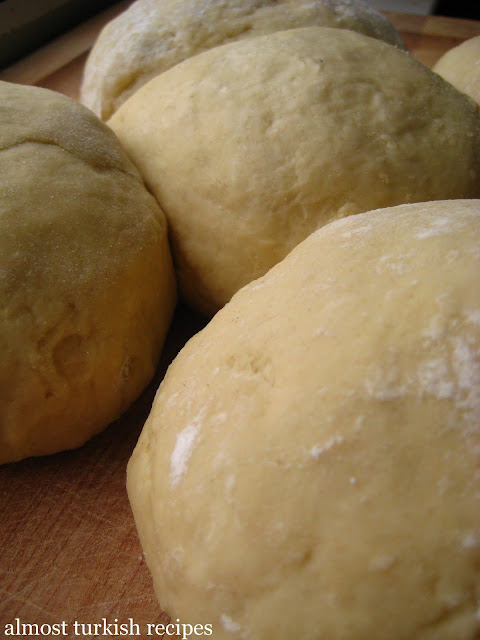
makes ~ 2 pounds of Turkish egg noodles
5 eggs
1/2 liter milk
1 kilo / 2.2 lb flour
1 cup semolina
1 tsp salt
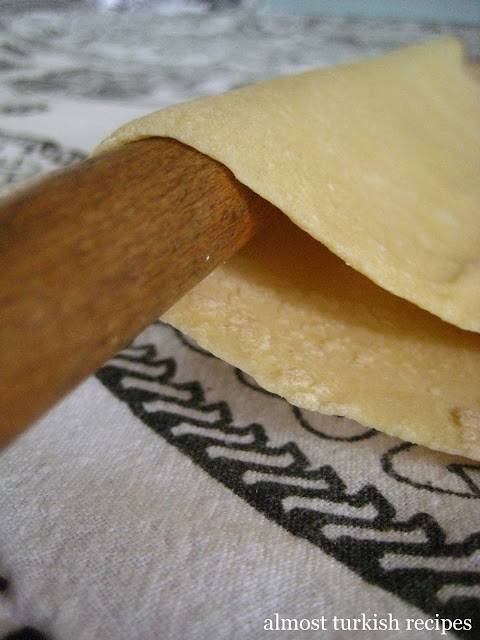
-Beat eggs well.
-Add milk and salt and beat again.
-Put the flour, semolina, and salt in a big bowl. Make a pool in the middle by pushing flour to the sides. Pour egg and milk mixture into this pool.
-Start bringing flour to eggy mixture and kneading. Knead until you have a firm enough that it wouldn't stick to your hands yet soft enough so that you can roll it.
-Divide the dough into 5-6 equal parts. Cover them with a clean kitchen towel and let rest for half an hour.
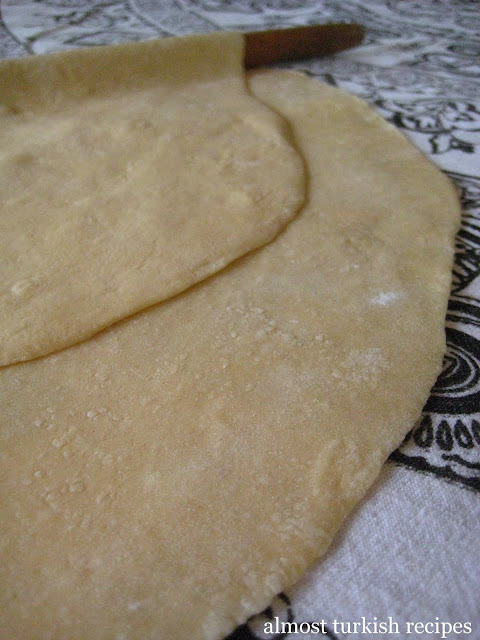
-Sprinkle flour on the counter or your work space.
-With a rolling pin roll each dough out into circles, about 22-23 inch / 55-60 cm in diameter and 0.1 inch / 2 mm thick.
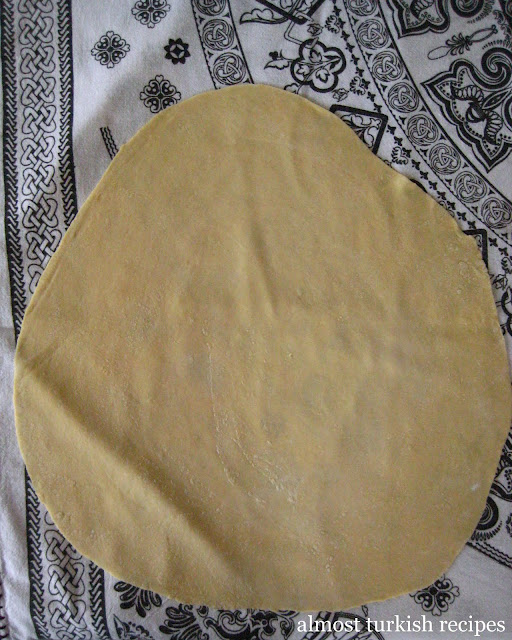
-Lay these dough sheets on a clean table cloth in a room away from direct sunlight and let dry.

-They should be dry enough so that when you cut it with a knife it wouldn't stick yet not too dry so that it would break. ~8 to 12 hours.
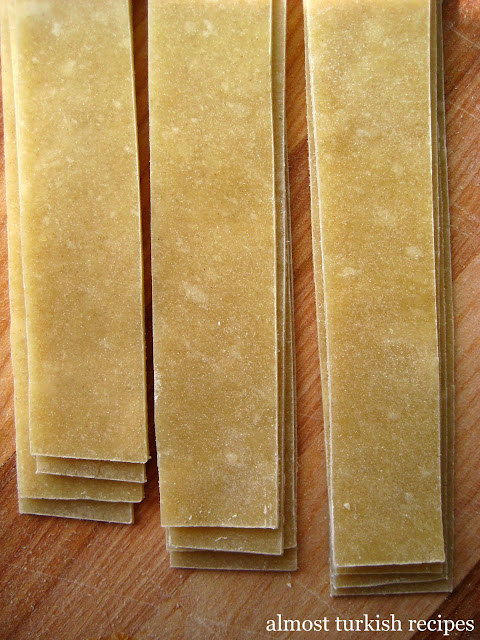
-First cut each circle into 1.5 icnhes / 3-4 cm wide strips.
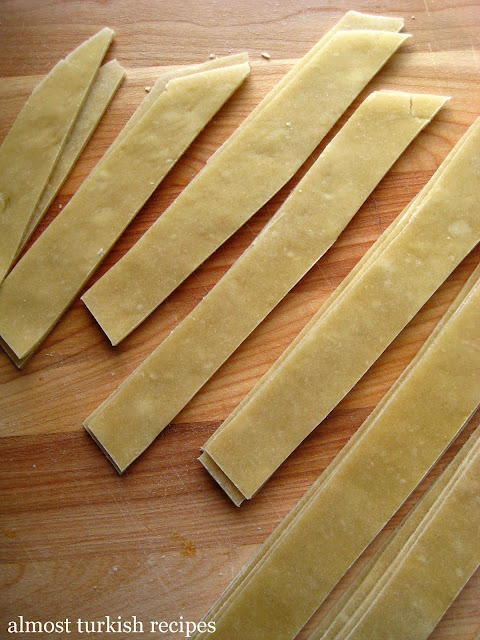
-As you can see they don't have to be perfect.
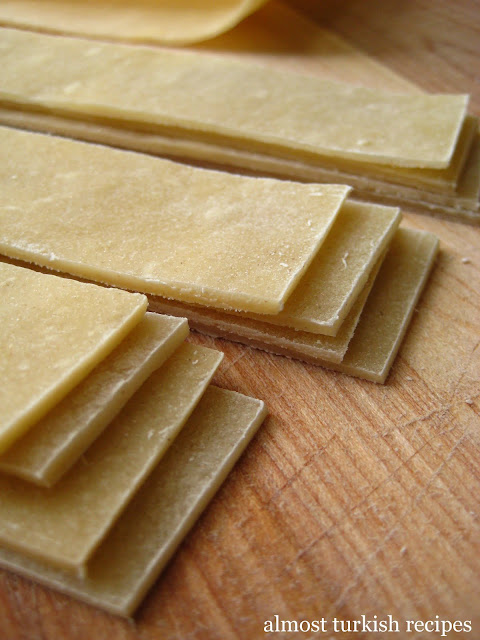
-Now stack 3 or 4 of those strips, and cut them horizontally into matchstick forms.
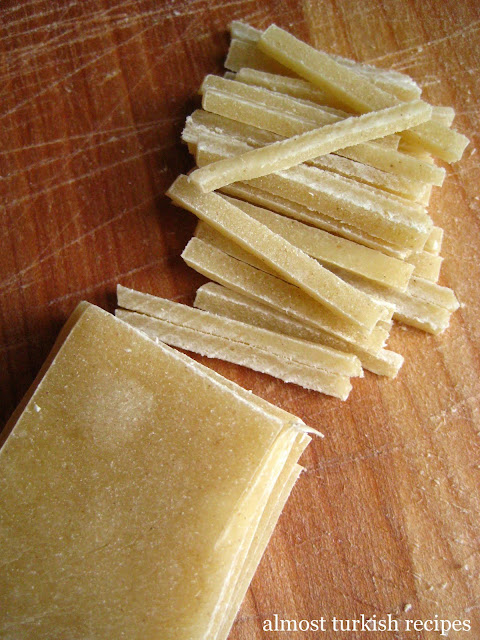
-Lay noodles back on table cloth to really dry for another day or two. Make sure they don't stick to each other. Separate them with your hands.
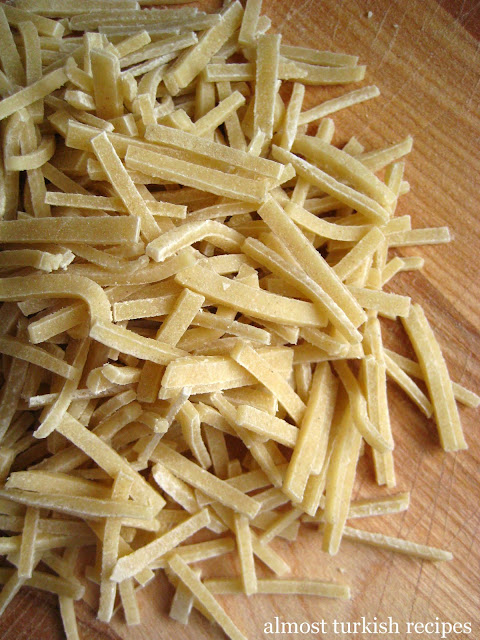
-After cutting matchstick shape noodles, you will have odd shape leftover noodles at the ends of the strips. Save them and dry them as well to use in soups.

Now, how to make Turkish egg noodles. Simple. The ratio of noodles to water is 1 to 2, similar to rice.
serves 2 people
2 cups of egg noodles
4 cups of water
1 tsp salt
2-3 tbsp butter ( my personal preference) or olive oil
crumbled Turkish or Bulgarian white cheese or Greek feta
ground walnuts
-Boil 4 cups of water with salt and butter/oil.
-Once it boils, add noodles and cook on low-medium with the lid slightly ajar until noodles soak all the water.
-In my family, noodles are served with crumbled white cheese and ground walnut on top, but you can certainly be creative.
Bon appetit!
What a nice recipe! I like all the photos that accompany it.
ReplyDeletePass me a fork please.
ReplyDeleteWow! This looks great, I should definitely try it!
ReplyDeleteWith all my respect,there is no bulgarian feta.
ReplyDeleteFeta is a greek P.O.P. product.
Your egg noodles is our xylopites...veeeery tastefull!
Your blog is wonderfull :)
Katerina
Dear Katerina,
ReplyDeleteWith all my respect too, if you take a careful look here in the recipe it is not called Bulgarian Feta but instead Bulgarian cheese. And to be honest not only my opinion as a Turkish person but also some other different nationalities, both Turkish and Bulgarian white cheese are much harder, fattier but also much tastier than the usual Greek feta.
Hatice
To Katerina and Hatice: Hatice, I did write "Bulgarian feta" in the recipe but I changed it to "Bulgarian white cheese" after Katerina's comment.
ReplyDeleteAnd Katerina, I didn't mean to offend anyone and cause cheese crisis, but I used to buy Bulgarian white cheese which was always labeled as "Bulgarian feta." I am not sure if that's what it said on the original package, but in 3 different stores where I used to buy it, it was always labeled and marketed it as "Bulgarian feta." So out of habit I called it feta, but not anymore!
as the cheese matter sounds really serious,i think it should be taken to Hague along with other issues.
DeleteI didn't mean to cause any trouble too. I just made a notice after a carefull reading on the recipe as we have to respect tradition and law.
ReplyDeleteI know that a cheese similar to feta is produced all over the Balkans and Turkey but can't be named feta. And I don't doubd that this cheese is maybe more tastefull than feta as I prefer the hard feta too. :)
As a conclusion, I like to taste and learn anything traditional without prejudices.
Sorry for my english.
Have a nice and tastefull 2010.
Katerina
No worries, Katerina. Have a happy new year!
ReplyDelete:)
ReplyDeleteHome made noodles are always outstanding!
ReplyDeleteHappy Holidays to you and the family.
Very interesting! I bet it is delicious too! I have seen homemade noodle recipes in Lebanese cuisine, but they are served either with yogurt or lentils!
ReplyDeleteI am having fun with the back and forth comments regarding feta. I like French Feta the best! There!
ReplyDeleteVery strange way of having fun...
ReplyDeletewhat more to say when respect is missing?
K.
If you simply say 'white cheese' to English or American people they wouldn't know about the soft white cheeses we use in cooking. What Burcu is trying to do it make recipes accessible to the wider audience - hence the use of the word 'feta' - so people identify what texture of cheese should be used :)
ReplyDeleteLet's not get carried away by the politics. 'Una faccia, una razza' is what I say :)
Burcu, I am making this recipe tonight.
Adina x
I came across your blog while looking for some recipes with noodles and liked a lot. How amazing! I will keep an eye on your post.
ReplyDeleteI never knew this is such a great dish. Now we order them from www.TurkishBazaar.ca. Great taste, home made and fresh. :)
ReplyDelete